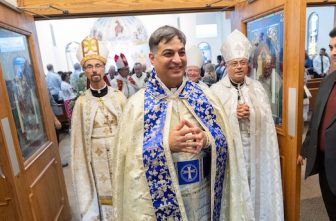
As Jesus appeared on the scene in Galilee teaching a new message that he called the good news, people asked the question: “By whose authority do you presume to teach? Where do you and your message come from?” Jesus, knowing that his words alone were not enough to convince everyone of his authority, combined them with wondrous actions and deeds that would earn him credibility in people’s eyes.
Our Gospel passage today is one of those shows of power meant to reinforce the faith of his disciples. As Jesus walked across the water, as he calmed the turbulent waters, the disciples were given a powerful insight into his identity.
An important image that is prominent in our passage today is a boat. In 1986, the level of the Sea of Galilee was extraordinarily low. An ancient fishing vessel that had been buried in the mud was discovered. Carbon 14 tests concluded that the boat had been built between the years 40 BC and 70 AD. No one has claimed that this is the exact boat used by Jesus and his disciples; but it does give us a picture of the boat used on the Sea of Galilee at that time.
Boats have been prominent in the history of Christianity. Jesus preached from a boat to the crowds gathered along the shore. It was by sea that Peter traveled to Rome and established it as the seat of Christianity. It was by sea that Paul traveled around the Mediterranean region, evangelizing in the name of Jesus Christ. It was by sea that missionaries in every age after Paul have taken the good news to people who would hear it for the first time. And boats have become an important part of our iconography.
But there is a deeper level of meaning at work in our Gospel passage. Already in the days of Matthew’s community, a boat had become a symbol for the Church. They would have understood the significance of this passage to be that no matter what the struggles or trials faced by the Church, we should never lose faith. God will be our protector and defender no matter what storm may beset us. In Matthew’s community, there were struggles and there was persecution. So, this is a message meant to give them hope. But there is a personal dimension here as well. Jesus did not let Peter drown in the midst of a personal trial. He shows himself to be patient with us as well; he will never abandon us in our struggles. Jesus is always there with hand outstretched, ready to lift us up again. Like Peter trying to walk across the water, when we lose sight of who is supporting us and look only to ourselves, it is then that we falter. We must never forget who it is who calls us to come across the water.
But it is not enough to simply seek God at the tumultuous or stormy times of our lives. God is to be found in the ordinary, in the day-to-day. Some of the greatest leaps forward in Christian spirituality came from hearing God speak in quiet tones: Benedict at Subiaco, Francis at LaVerna, Ignatius at Manresa, Teresa in her Spanish cloister. And more recently, Dorothy Day as she simply stopped by a church and knelt before the Blessed Sacrament. Each of them made the time and the space to let God penetrate their lives, to speak in a whisper.
We are people of faith; but faith needs to be nurtured. Just as in the storm we focus on our need for safety, so each day let us spend some time focused on what is safe, powerful and holy: our relationship with God. Then we need fear no more.
Father Snyder is a retired priest of the Archdiocese of St. Paul and Minneapolis who previously worked at Catholic Charities and the University of St. Thomas.
Sunday, Aug. 13
Nineteenth Sunday in Ordinary Time




